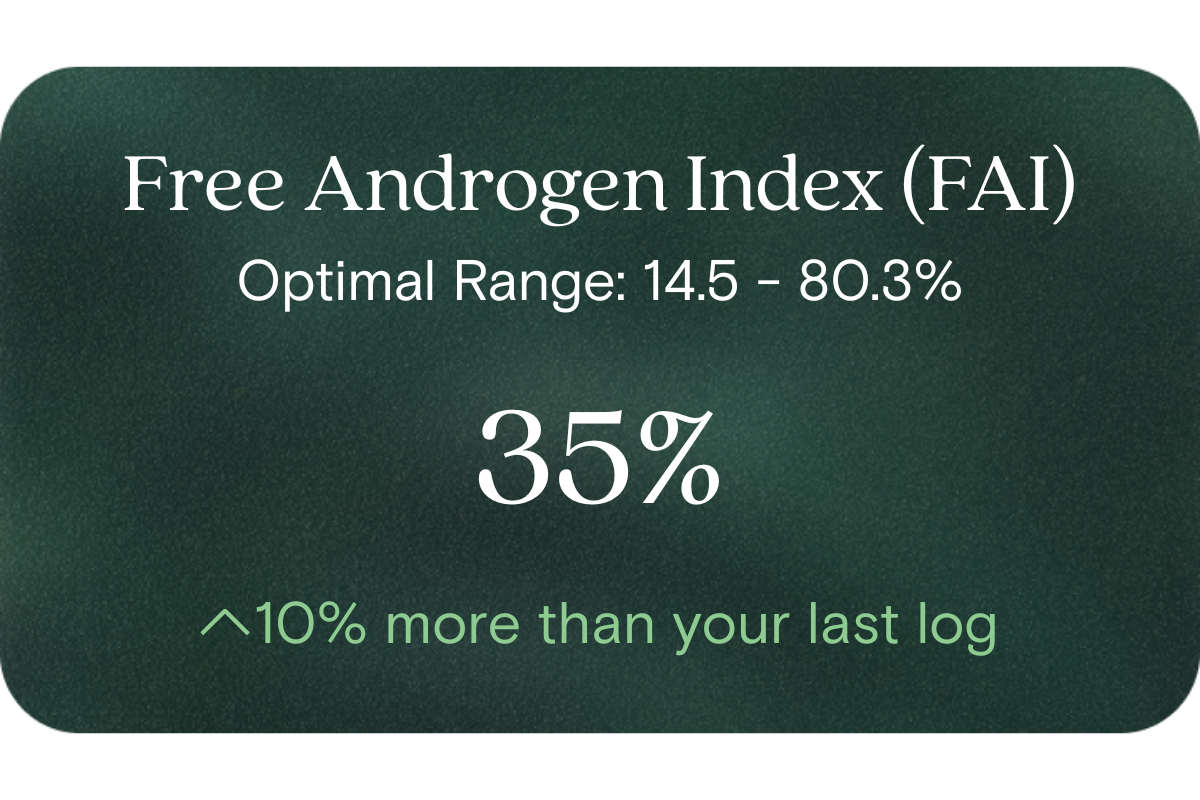What is Free Androgen Index (FAI)?
FAI is an indirect estimate of how much testosterone in the bloodstream is unbound and potentially bioactive. It is calculated by dividing total testosterone by SHBG (sex hormone-binding globulin) and multiplying by 100, yielding a percentage value.
Why does it matter for long-term health and wellbeing?
Because only the free or bioavailable portion of testosterone is able to bind to androgen receptors in tissues, FAI more closely mirrors functional androgen signalling than total testosterone alone. Balanced androgen signalling supports muscle maintenance, metabolic flexibility, mood, energy, sexual function and healthy body composition. Over time, deviations in FAI may herald shifts in metabolic or hormonal balance before overt changes in weight, strength or vitality emerge.
What’s an optimal level of FAI?
- Laboratory (reference) range: 14.5 % to 80.3 %.
- Optimal (target) range: (To be defined based on population cohort data, age and sex; currently not universally agreed).
Because FAI reference ranges vary by lab, age, assay and sex, the optimal window should be anchored to your individual baseline and clinical context. (In many published sources, “normal” female FAI values lie in a lower single-digit percentage range, and many labs caution that FAI is lab-dependent.)
What influences FAI levels?
- The levels of total testosterone (production, secretion, peripheral conversion)
- The levels of SHBG (which bind and sequester testosterone)
- Age, body composition (adiposity vs lean mass), insulin sensitivity, inflammation, thyroid function, liver function and nutritional status
- Hormonal factors such as oestrogen, cortisol, growth hormone and insulin
- Lifestyle factors, including exercise, sleep, diet, weight, alcohol, certain medications or supplements
What does it mean if FAI is outside the optimal range?
- Below optimal / low FAI suggests that less testosterone is bioavailable (relative to how much is produced). This may reflect relatively high SHBG, low testosterone formation, or shifts in binding dynamics. Over time, it may trend with reduced anabolic tone, lower energy or gradual loss of strength or vitality (even if within “normal” lab limits).
- Above optimal / high FAI suggests a greater proportion of free androgen activity relative to binding. In some contexts this may correlate with stronger androgen signalling, which—if unchecked—can stress metabolic or hormonal homeostasis.
In either case, deviations are best viewed as early signals or “warning flags” for lifestyle optimisation (rather than diagnostic thresholds).
How can I support healthy FAI levels?
- Moderate resistance and high-intensity training to promote anabolic stimulus
- Optimising body composition (maintaining or increasing lean mass, reducing excessive fat)
- Diet quality focusing on macronutrient balance (adequate healthy fats, protein, fibre)
- Improving insulin sensitivity (e.g. via exercise, weight management, sleep)
- Ensuring high quality sleep and stress regulation
- Supporting liver health and hormonal homeostasis
- Avoiding extremes in diet, over-training, or exposures that disrupt endocrine networks
This information is provided for general health and wellness purposes only and does not replace medical advice.
References
- Royal College of Pathologists of Australasia. (2024). RCPA Manual: Free Androgen Index (FAI).
- Yeap, B. B., Grossmann, M., McLachlan, R. I., et al. (2016). Endocrine Society of Australia position statement on male hypogonadism (part 1): Assessment and indications for testosterone therapy. Medical Journal of Australia, 205(4), 173–178.
- Vermeulen, A., Verdonck, L., & Kaufman, J. M. (1999). A critical evaluation of simple methods for the estimation of free testosterone in serum. Journal of Clinical Endocrinology & Metabolism, 84(10), 3666–3672.
- Monash Health Pathology. (n.d.). Reference Intervals Master List. Monash University.




















.png)
